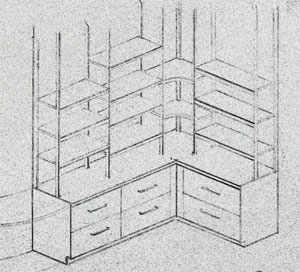Like the proverbial shoemaker’s children that are perpetually barefoot, my own home doesn’t have a whole lot of furniture that I built myself. I save most of my woodworking energy for building projects for the  Woodworker’s Journal or when I do “pro bono work” for the Shakespearean theater company that my wife works for (the latter has consisted of mostly creating large, freestanding poster displays and a collection box).
Woodworker’s Journal or when I do “pro bono work” for the Shakespearean theater company that my wife works for (the latter has consisted of mostly creating large, freestanding poster displays and a collection box).
But every once in a while, a project comes along that I have difficulty saying no to. In this case, I was recently contacted by a prominent local business owner who lives in a gorgeous house only a half a block from one of the most beautiful stretches of coastline that California has to offer. He asked me if I would consider building him a large L-shaped shelf unit that would wrap around a partially curved wall in his home office/man cave.
The unit has to serve a number of different purposes: 1. To hold a fairly large collection of books on audio, music, software design and other technical topics (this man is one of the owners of a prominent professional audio equipment and musical software company). 2. To house a wi-fi router, printer, and other pieces of peripheral computer equipment. 3. To organize and protect a large collection of vintage comic books. 4. Provide a way to store assorted pieces of equipment and accessories out of sight, to keep the room from looking cluttered. 5. Provide diffuse lighting in the room. The design of the piece has to fit in with the architectural style and materials of the man’s home, which is built in what I’d call “California contemporary beach” style, with lots of clear-finished wood (floors, stairs, cabinets, trim) with stainless steel accents (railings, balusters, door and cabinet hardware) and, of course, a ton of windows to let in all that fabulous California sunshine (I’m saying this tongue-in-cheek, as we’re currently being bombarded by a rainstorm that’s supposed to last for nearly a week!).
Considering the biggest specific purpose of the unit — housing vintage comic books — I began my design process by figuring out how best to store and organize all those comics, yet provide my client with ready access to them. Pullout drawers on full-extension guides seemed the best solution, and because there are enough comics to create a stack 18 feet high (!!), the design called for two layers of wide drawers on both the legs of the shelf unit. Each draw would hold two side-by-side stacks of comics stored on-edge. This arrangement creates a low console about 18 in. deep and 26 in. high, which I thought would give the unit good visual weight (see my preliminary sketch). To keep the rest of the unit visually lighter, I decided to use 3/8 in. by 1 ¾ in. stainless bar stock for the shelf standards to support the cherry wood shelves. The steel standards would be brush finished, to match other stainless hardware in the house.
Where the long end of the “L” shape section of the unit wraps around a gently curving wall, I decided to make a curved cabinet at the end of the lower console with a pair of coopered doors that follow the curve of the wall. The shelves above the curved cabinet have a smaller front edge radius curve, while the back edge matches the wall’s curve. At the top of the unit, the stainless standards terminate into a fixed-top shelf that’s 10 in. below the room’s ceiling. Shallow light fixtures (probably LEDs) controlled by a dimmer mount atop these shelves, to provide diffuse room lighting. A lip molding at the edge of this top shelf helps conceal the fixtures.
That’s as far as I’ve gotten with the shelf unit so far; stay tuned for future blog entries where I’ll report on the progress of this project.
Sandor Nagyszalanczy






